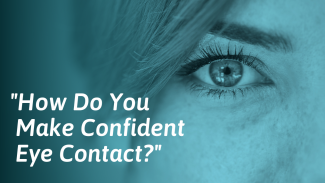If you tend to feel self-conscious in social situations, you might be wondering how to position your hands in a way that makes you appear confident, friendly, and relaxed. In this guide, you’ll learn what to do with your arms and hands when you’re standing up.
Sections
- What to do with your hands when you’re standing in public
- What to do with your hands in photos
- Common questions
What to do with your hands when you’re standing in public
Here are some general tips to keep in mind when you want to seem approachable and relaxed in a social setting.
1. Keep your arms and hands by your sides
Standing still with your hands hanging loosely by your sides is a good neutral position. Standing this way may feel weird or forced at first, especially if you are a naturally fidgety person, but it will probably feel easier and more natural with practice. It may help to try it a few times in front of a mirror.
Avoid clenching your fists because this can make you come across as aggressive or stressed.
Alternatively, place your thumbs in your pockets while keeping your fingers on display. Try not to stand with your hands in your pockets because it can make you come across as untrustworthy,[1] bored, or aloof.
2. Do not hold anything in front of your body
Holding objects in front of your chest can make you appear defensive. Other people may interpret it as a sign that you don’t want to interact with them. If you need to hold or carry something—for example, a drink at a party—hold it in one hand and relax your other arm by your side. Try not to fold your arms across your chest because this can make you come across as closed-off.[2]
3. Try not to fidget
Fidgeting can annoy other people and be distracting during a conversation, so keep it to a minimum. Try wiggling your toes instead of fidgeting with your hands. This can help you get rid of nervous energy without distracting anyone else.
4. Keep your hands away from your face and neck
Touching your face can make you come across as untrustworthy,[3] and rubbing or scratching at your neck can make you look anxious.
In some cases, a simple fix is enough to solve the problem. For example, if your skin tends to be itchy, moisturizing regularly might stop the urge to scratch. Or if you often feel the need to move your hair away from your eyes, try styling it differently.
It can also help to keep count of how many times you touch your face and neck over a 30-minute or one-hour period. If you do this several times, it can make you more aware of your behavior, which in turn might make it easier to stop. You could also ask a friend to help you break the habit by giving you a verbal or non-verbal signal when they notice you reaching up to your face or neck.
There are also devices available that vibrate when you touch your face, such as the Immutouch, which can help you to stop.
5. Use hand gestures to emphasize your points
When you’re talking to someone, hand gestures can make you more engaging.
Here are some examples of hand gestures you can try:
- When you want to make several points, raise one finger while sharing your first point, two fingers while communicating your second point, and so on. This can be an effective way to keep your audience focused.
- Use your hands to indicate the concepts of “more” and “less” by holding them in front of you so that your palms are parallel, then moving them closer together or further apart.
- Hold up a pair of crossed fingers when you want to emphasize that you really want something to happen.
- If you are using visual aids such as slides, during a speech, gesture towards them to emphasize a point and to encourage the audience to look at the visual aid rather than you.
Rapid, choppy gestures can be distracting.[4] As a general rule, strong, deliberate hand movements are more effective[4] and signal confidence.
Don’t point at people unless absolutely necessary because it often comes across as confrontational. Only do it when there’s no other way of identifying someone else. For example, it’s OK to point at someone across a large, noisy room if you need to identify them. If you are giving a speech, it’s best to avoid pointing directly at the audience when you’re presenting.[4]
Try to keep your hands in the “strike zone.” The strike zone starts at your shoulders and ends at the top of your hips. Gesturing outside of this zone can come across as overly energetic or flamboyant.
Science of People has put together a list of 60 hand gestures plus tips on how to use them.
7. Consider rehearsing your gestures before a speech
Some public speaking consultants and authors of books on body language recommend practicing gestures when you’re preparing a speech. But others believe movements shouldn’t be rehearsed and that it’s better to do what feels natural in the moment.[4]
It’s up to you; if you feel that practicing gestures before giving a talk or presentation helps you to feel more confident, it could be a good strategy.
8. Mirror other peoples’ movements
Research has shown that people may be more inclined to like you if you mimic their movements and mannerisms.[5] This means that imitating someone’s hand positions and gestures could build rapport.
But it’s not a good idea to mirror the other person by copying every gesture they make. They’ll probably notice what you’re doing and will start to feel uncomfortable. Instead, try to match their overall energy level.
For example, if they are high-energy and tend to gesture frequently with both hands, you can do the same. Or if they don’t talk with their hands very often, keep yours in a neutral position most of the time.
What to do with your hands in photos
It’s normal to feel self-conscious when someone is taking your photo. If you aren’t sure what to do with your hands, here are a few suggestions:
- If you are standing next to someone you know, put one arm around their shoulders and let your other arm relax by your side. If you’re standing next to a partner or close friend, put your arm around their waist or give them a hug. It’s not always easy to judge whether someone will be comfortable with physical contact, so if you aren’t sure, ask first.
- Striking a funny pose is fine in some situations. For example, if you’re at a big, raucous party, giving a thumbs up and a big grin is OK; you don’t need to look dignified in every photo.
- If you can find any old photos of yourself that you like, look at where you are placing your hands. You can try and use the same positions in the future. It may help to practice a few go-to poses alone in a mirror so you know what to do when someone wants to take your picture.
- If you are outdoors, for example, on a hike or camping trip, try using expansive gestures that give a sense of space. For example, you could spread your arms out wide.
- If you are sitting or standing in a neutral pose with your arms hanging down by your sides, lift your arms slightly away from your body. This will stop your arms from looking squashed in the photo.
- You can hold a prop or object in one or both hands if it makes you feel more comfortable. For example, if you are at the beach, you could hold an ice cream or sunhat.
Common questions
How can you improve the way you talk with your hands?
Keep your gestures smooth and deliberate because choppy, quick movements can be distracting. To avoid coming across as overly enthusiastic or frantic, try to keep your hands below your shoulders but above hip height when you gesture. It may help to practice gestures in front of a mirror.
How can you improve your hand gestures when presenting?
Make sure your gestures are well-timed so that they emphasize your most important points. Move your hands with a sense of purpose to make your meaning clear. It may help to rehearse your gestures when you rehearse your presentation.
Why am I always doing something with my hands?
Gesturing or “talking with your hands” is a normal part of communication. But if you feel the need to fidget a lot, for example, by tapping your fingers or playing with a pen in social situations, it may be because you are nervous.[6] A strong urge to fidget can also be a sign of ADD/ADHD.[6]





